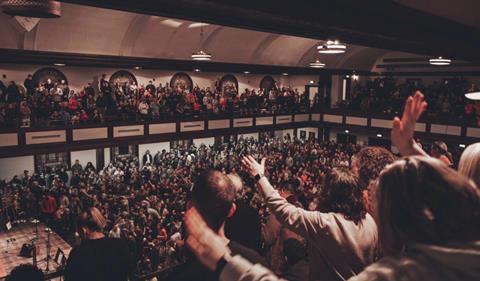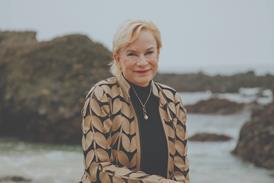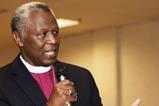An estimated 50,000 people descended on the tiny town of Wilmore, Kentucky as spontanteous 24-7 prayer and worship broke out on a university campus. Tim Wyatt reports

It all started at an ordinary Wednesday chapel service in February, at a tiny Christian college in Kentucky called Asbury University. After the usual service ended, a small number of students decided to carry on praying and worshipping. And they didn’t stop. Gradually, more and more students joined them in what would become an endless stream of singing and praying, confessing and communing, sensing something of the Holy Spirit present with them.
As word of what was now being called the Asbury Revival began to spread, Christians started arriving to see what was going on in the Hughes Auditorium. First, it was just locals from the nearby town of Wilmore. But, by day four, the media had picked up on the extraordinary scenes and people begin arriving from further afield. Videos went viral on social media and the steady flow of visitors turned into a torrent.
Jessika Tate, a missionary and author who lives in Nashville, about three hours’ drive from Asbury, arrived on day three. Unlike others, who spoke of immediately feeling overwhelmed when they entered the chapel, Tate said her initial response was more muted. But as she lingered, she began to “feel the presence of God in a really unique way”.
After a late-night session with only a few hundred others, the following day she entered the sanctuary and was overcome with tears. “I just go: ‘Oh my goodness, he’s here’ and I started weeping. The presence of God was just so thick.” Rather than scheduled services, there was more of a “prayer room model”, she explained, with largely unplanned, round-the-clock worship 24 hours a day.
Bill Elliff, a pastor in Arkansas and leader of a revival ministry, was another one of those who headed to Asbury to grab a taste of the outpouring in that first week. In an astonishing coincidence, his organisation, OneCry, had been planning to broadcast the annual Collegiate Day of Prayer from the university in late February for more than a year. In the end, that service was chosen to bring the Asbury Revival to a close. Having experienced a campus revival as a student in 1970, Elliff said he knew: “God can do more in five minutes than in 50 years of normal Christianity.” So when he heard about the events at Asbury, he knew he had to be there.
But what was it like when he entered the chapel? “You walk in expecting your hair to go on end or be blown back three steps, but it’s not like that at all. It wasn’t crazy. In fact, it was more silent, it was more sombre, with outbreaks of glorious praise, all spontaneous and student-led.”
Teams of students would rotate in leading worship, while prayer teams and campus pastors gathered at the front and sides for ministry. At times, Elliff said, the singing would pause for testimonies, and people would stream forward to tell stories of what God had been doing. The things happening at the altar in the Hughes Auditorium were “extraordinary”, he said: “Salvation, spiritual and emotional, some physical healings, deliverance from so many things. Just a calm, beautiful, powerful, palpable moving of the Spirit of God.”
A new generation
Asbury has been described as the first Gen-Z revival, with most of the students spearheading it in their late teens or early 20s. Shaky videos of the packed auditorium spread like wildfire on TikTok. Just ten days after the outpouring began, the hashtag #asburyrevival had been viewed more than 60 million times. After the first week, as tens of thousands of Christians from around the world besieged the tiny town of Wilmore, the university limited access to the main auditorium to those under 25, prioritising the generation which had launched the revival.
As well as being strikingly spontaneous, the revival was also noticeably leaderless. As the cycle of anonymous musicians kept the worship going, the only speakers were non-famous locals or university staff. There has been no charismatic central figure to emerge from the movement so far, with the students instead consciously placing the focus on God.
Tate said that while university leaders were present, they intentionally deferred to the students in stewarding the outpouring, praying and guiding from behind. It had been “hungry” students who had sparked the revival, and so they should be the ones to finish it too, one person told her. While many profess to love the idea of a “nameless generation”, these young Gen-Zs in Asbury were living it out, she said.
Elliff said he felt like young Christians were “tired of the hype, the fog machines, the prep, the leaders who disappoint”, adding that the spirit of the revival was one of “unbelievable humility”. What the American Church needed was not yet another programme, campaign or megapastor, but for God to do what he has tended to do in the US every 30 to 60 years – another Great Awakening, Elliff concluded. “And that comes when God just chooses in his mercy to make himself known.”
Spreading out
Despite the students’ best efforts, Christians hungry for a taste of revival – and some perhaps keener to fuel their own ministries – continued to arrive. As queues outside the auditorium got longer, the feeling of the movement began to shift.
A fortnight in, the town of Wilmore – population just 6,000 – was bursting at the seams. There were no hotel rooms for miles around and barely enough food to feed the estimated 50,000 people who had flocked to Asbury.
As a result, the university decided to wind down the non-stop worship services after the long-planned Collegiate Day of Prayer. Revival hunters were urged to carry the flame from Asbury back to their own communities. “Jesus calls us to go out. So now that we have come in and received [an] amazing filling up, it’s truly time to go out and share the gospel, and carry the light and fire into our local communities,” said one Asbury official.
Elliff said he had already seen signs this was starting to happen – within days there had been reports from dozens of other university campuses of students gathering for hours upon hours to worship God. A fellow church leader from Mississippi said that at the first Sunday church service after the Asbury Revival kicked off, 106 people came to Christ and were baptised. In Texas, another pastor friend held nightly worship services for a week, which culminated in 60 people being saved on the Sunday. “I am cautiously but expectantly hopeful that this will explode, and that we will see the next Great Awakening,” he said.
USING TECHNOLOGY
John Maiden, a professor of church history at the Open University, said the Asbury revival was particularly distinctive compared to recent outpourings, such as the 2008 Lakeland Revival in Florida or the 1990s’ Toronto Blessing. Both centred on charismatic individuals, featuring more intense worship music and ‘showmanship’ on the stage, he explained.
In contrast, the low-key nature of Asbury harked back to earlier forms of revivalism. During the 18th century, when Methodism exploded into life, revivals were marked by spontaneous worship, preaching and charismatic phenomena such as speaking in tongues, rather than orchestrated services.
But Asbury was mainstream in how it was mediated using technology. Revivals have long spread through the communication channel of the day, Maiden explained; first printed text, then radio in the 1920s, television in the 1950s and cassette tapes during the Charismatic Renewal in subsequent decades. Maybe Asbury will go down in history not just as the first Gen-Z revival, but also the first social media one.
“A common feature of these revivals is that it is often a response to a sense of perceived crisis,” Maiden added. In previous generations, that may have been the Cold War, or the growth of secularisation. Perhaps Asbury students were responding to the fallout of Covid-19, which has resulted in record levels of anxiety and mental health struggles. “The desire to experience God’s presence is, in some ways, a response to the struggles that so many young people have today,” Maiden suggested. Its leaderless structure might also be a subtle pushback against the wave of abuse scandals among church leaders in recent years too.
Cynics and sceptics have accused Asbury students of getting carried away with their emotions, Tate said, but she had little time for this particular critique. “Were students emotional at Asbury? Absolutely. Should they be, when your heart is touched by the gospel in a radical way? I would say: ‘Absolutely!’” People are emotional beings, she added, and it was better to bring those emotions to Jesus than let them out at a bar or football game. “It is more scary and more threatening to the reality of the gospel when someone is unemotional when Jesus shows up, than when they are.”
For full coverage of the Asbury Revival, including first hand accounts from Vineyard UK’s Debby Wright and 24-7 Prayer’s Josh Green, see premierchristianity.com/asbury
To hear students from Asbury University discuss their experiences at the revival, download The Profile podcast





































No comments yet